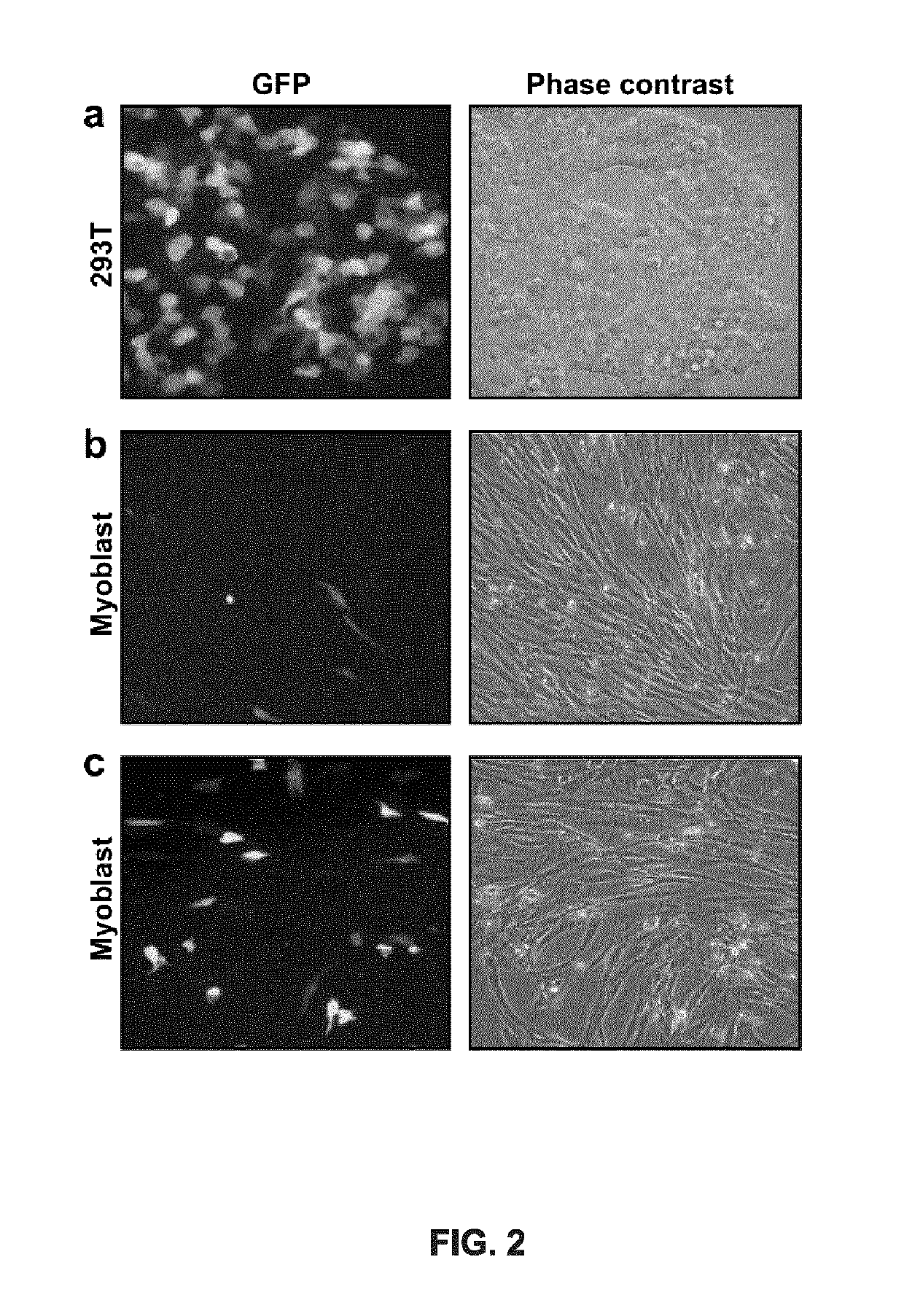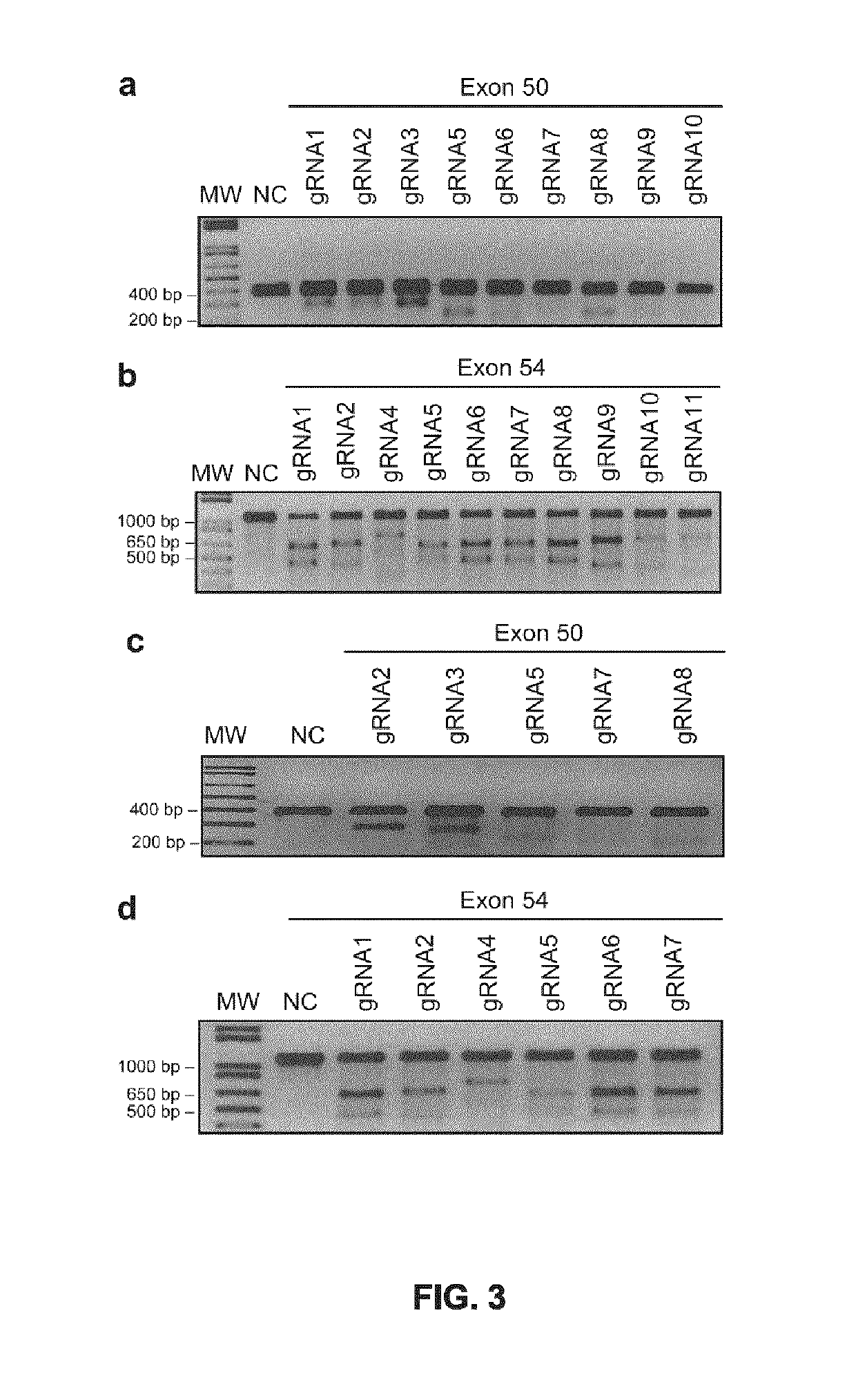Methods of modifying the dystrophin gene and restoring dystrophin expression and uses thereof
a dystrophin and gene technology, applied in the field of modifying the dystrophin gene and restoring the expression of dystrophin, can solve the problems of increasing the fragility of the dystrophin gene, no cure for dmd and bmd, muscle weakness, etc., and achieves the correct reading frame, sufficient dystrophin protein function, and smallest deletion possible
- Summary
- Abstract
- Description
- Claims
- Application Information
AI Technical Summary
Benefits of technology
Problems solved by technology
Method used
Image
Examples
example 1
Materials and Methods for Examples 1 to 7
[0206]Identification of targets and gRNA cloning. The plasmid pSpCas(BB)-2A-GFP (pX458) (Addgene plasmid #48138) (FIG. 1a) [58] containing two Bbsl restriction sites necessary for insertion of a protospacer (see below) under the control of the U6 promoter was used in the experiments shown in FIGS. 1 to 8. The pSpCas(BB)-2A-GFP plasmid also contains the Cas9, of S. pyogenes, and eGFP genes under the control of the CBh promoter; both genes are separated by a sequence encoding the peptide T2A.
[0207]The nucleotide sequences targeted by the gRNAs in exons 50 and 54 were identified using the Leiden Muscular Dystrophy website by screening for Protospacer Adjacent Motifs (PAM) in the sense and antisense strands of each exon sequence (FIG. 1b). The PAM sequence for S. pyogenes Cas9 is NGG. An oligonucleotide coding for the target sequence, and its complementary sequence, were synthesized by Integrated DNA Technologies (IDT, Coralville, Iowa) and clone...
example 2
Dystrophin Exon Targeting in DMD Myoblasts Using the SpCAS9 / CRISPR System
[0221]Twenty-four different pSpCas(BB)-2A-GFP-gRNA plasmids (FIG. 1a) were made: 10 containing gRNAs targeting different sequences of the exon 50 of the DYS gene and 14 containing gRNAs targeting the exon 54 (Table 3 and FIGS. 1b-c). To test the activity of these gRNAs, these plasmids were first transfected in 293T cells. Under standard transfection conditions, 80% of cells showed expression of the GFP confirming the effectiveness of the transfection (FIG. 2a). The DNA from those cells was extracted 48 hours after transfection. The exon 50 of the DYS was amplified by PCR using primers Sense 49 and Antisense 50 and exon 54 was amplified with primers Sense 53 and Antisense 54 (see Example 1 for details on primer sequences). The presence of INDELs, produced by non-homologous end-joining (NHEJ) following the DSBs generated by the gRNAs and the Cas9, was detected using the Surveyor / Cel I enzymatic assay (FIGS. 3a-b)...
example 3
Testing of gRNA Pairs in the SpCAS9 / CRISPR System
[0223]Given that the CRISPR / Cas9 induces a DSB at exactly 3 bp from the PAM in the 5′ direction, it was possible to predict the consequence of cutting of the exons 50 and 54 with the various pairs of gRNAs. This analysis predicted four possibilities, as illustrated in FIG. 4a and detailed in Table 4: 1) the total number of coding nucleotides, which are deleted (i.e., the sum of the nucleotides of exons 51, 52 and 53 and the portions of exons 50 and 54, which are deleted) is a multiple of three and the junction of the remains of 50 exons and 54 does not generate a new codon, 2) the number of deleted nucleotides coding for DYS is a multiple of three but a new codon, derived from the junction of the remains of 50 exons and 54, encodes a new amino acid, 3) the number of coding nucleotides, which are deleted is not a multiple of three resulting in an incorrect reading frame of the DYS gene; and 4) the sum of deleted nucleotides coding for ...
PUM
| Property | Measurement | Unit |
|---|---|---|
| thermal melting point | aaaaa | aaaaa |
| pH | aaaaa | aaaaa |
| pH | aaaaa | aaaaa |
Abstract
Description
Claims
Application Information
 Login to View More
Login to View More - R&D
- Intellectual Property
- Life Sciences
- Materials
- Tech Scout
- Unparalleled Data Quality
- Higher Quality Content
- 60% Fewer Hallucinations
Browse by: Latest US Patents, China's latest patents, Technical Efficacy Thesaurus, Application Domain, Technology Topic, Popular Technical Reports.
© 2025 PatSnap. All rights reserved.Legal|Privacy policy|Modern Slavery Act Transparency Statement|Sitemap|About US| Contact US: help@patsnap.com



